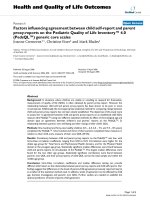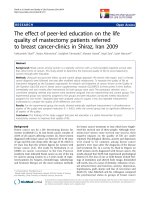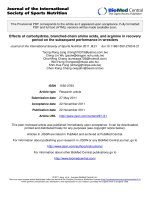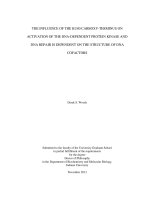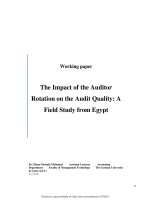Effect of supplementation of partially defatted peanut cake flour and dehydrated spinach leaves powder on the nutritional quality of Indian seasonal sweets
Bạn đang xem bản rút gọn của tài liệu. Xem và tải ngay bản đầy đủ của tài liệu tại đây (238.84 KB, 9 trang )
Int.J.Curr.Microbiol.App.Sci (2018) 7(3): 384-392
International Journal of Current Microbiology and Applied Sciences
ISSN: 2319-7706 Volume 7 Number 03 (2018)
Journal homepage:
Original Research Article
/>
Effect of Supplementation of Partially Defatted Peanut Cake Flour
and Dehydrated Spinach Leaves Powder on the Nutritional
Quality of Indian Seasonal Sweets
T. Bindhya Dhanesh1*, Anita Kochhar1 and M. Javed2
1
Department of Food and Nutrition, College of Home Science, Punjab Agricultural
University, Ludhiana, Punjab, India
2
Department of Stat, Math and Physics, College of Basic Sciences, Punjab Agricultural
University, Ludhiana, Punjab, India
*Corresponding author
ABSTRACT
Keywords
Partially defatted peanut
cake flour, Dehydrated
spinach leaves powder,
Traditional seasonal
sweets, High available
protein
Article Info
Accepted:
04 February 2018
Available Online:
10 March 2018
Partially defatted peanut cake flour is an under utilisied, cheap peanut by-product which is
packed with high available protein, energy, minerals and vitamins. Indian traditional
seasonal sweet products namely Pinni and Panjiri were developed incorporating partially
defatted peanut cake flour at 15% and dehydrated spinach leaves powder at 2% level so as
to increase its nutritional quality. The products were evaluated for its nutritional quality
along with its control to assess the increase in nutritional parameters. The nutritional
analysis of the products revealed a significant increase in the proximate composition
especially protein in the range of 19-20 per cent, fat 26-27 per cent, fiber 20-25 per cent
and energy 506-507 Kcal. Mineral composition like iron, calcium and zinc also increased
in the fortified products. Higher percent of in vitro protein digestibility and higher amino
acid profile was observed in the fortified products compared to the control which were not
fortified. Thus the study revealed that the value added products prepared by using partially
defatted peanut flour and dehydrated spinach leaves powder can be a promising solution to
eradicate malnutrition.
Introduction
India still ranks the highest in the rate of
undernourished children even though it has
witnessed significant progress in its battle
against child under nutrition over the past
decade. National Family Health Survey
(NFHS) has very recently reported that the
progress in eradicating malnutrition has shown
an uneven progress and the situation remains
high in many parts of the country (Live mint,
2017). The worst affected states were West
Bengal and Maharashtra where every second
child is undernourished.
Apart from poverty, the other key reasons for
child under nutrition are the status of women,
the kind of diet fed to the children and access
to good hygienic and sanitation facilities. Out
of these diet and poor access to healthy
balanced food is the main reason for the
increasing occurrence of child under nutrition.
384
Int.J.Curr.Microbiol.App.Sci (2018) 7(3): 384-392
Reduced dietary diversification has serious
effect on the nutrition and health of rural and
urban population and deprives rural farmers of
opportunity to generate income from their
produce, whereas dietary diversification is
widely accepted as cost-effective and
sustainable way of improving malnutrition
(Tontisirin, 2014). Underutilised food
resources constitute to the bedrock of the
diversity in traditional food systems of
developing country communities and tribes.
One such underutilized by-product is partially
defatted peanut cake flour.
Defatted peanut meal is a by-product left after
the oil extraction of peanuts. This meal can be
dried and ground into flour which can be used
in many recipes to improve nutritional quality.
Peanuts are a rich source of protein and have a
desirable fatty acid profile and are a rich
source of minerals and bioactive compounds
(Zhao et al., 2012). Compared to peanuts,
defatted peanut flour is of better quality
because availability of protein is increased
after deoiling. Defatted groundnut flour
produced from cake blends easily with any
flour and enhances the nutritive value of
wheat flour and other flour products (Purohit
and Rajyalakshmi, 2011).
In India, significance of peanut flour has
started to gain significance because of its high
nutritional profile and also in developing cost
effective food formulations such as in candies
and biscuits (Bassey et al., 2013).
Hence the present study was undertaken to
develop two traditional sweet value added
products using partially defatted peanut cake
flour along with small quantities of dehydrated
spinach powder. The products were analysed
for their nutritional composition so as to check
by how far their nutritional profile can be
enhanced and whether these products may be
fit to be introduced in various nutritional
feeding programmes.
Materials and Methods
Purchase and processing of ingredients
Wheat flour, Chick pea flour, Raw peanuts,
spinach leaves as well as other ingredients like
oil, ghee and powdered sugar were procured
from the local market of Ludhiana in a single
lot. Peanuts were purchased and checked for
any infestation or damage. They were roasted
and de-skinned. Oil was extracted by using oil
extraction machine.
The residual cake was then collected and
further dried in the oven at 65 ºC for half an
hour. Dried cake was ground to fine powder.
Spinach leaves were procured dried in a tray
drier at 60°C for 5-6 hours (constant weight
was achieved in this time). The dried spinach
and fenugreek leaves were ground to fine
powder- spinach leaf powder (SLP) and
fenugreek leaf powder (FLP) stored in
separate airtight containers.
Preparation of Pinni and Panjiri
Two traditional Indian sweet products namely
Pinni and Panjiri were developed. The basic
ingredient used for the products was cerealpulse mix flour. Pulse flour was taken in onethird amount of cereal flour. This mix was
replaced for the main ingredient listed in the
standard procedure. Wheat flour was used as a
cereal source and chickpea flour was used as a
pulse source. The standard procedures used
for product development were as follows:
Pinni - Wheat flour (100g) is roasted in 50g
ghee and mixed well with powdered sugar
(Bansal, 2013).
Panjiri - Wheat flour (100g) is roasted in 60 g
of ghee. It is then removed from flame and
mixed well with powdered sugar and rolled
into small ball when warm (Nagi and Mann,
2003).
385
Int.J.Curr.Microbiol.App.Sci (2018) 7(3): 384-392
The value added products were prepared with
partially defatted peanut cake flour and
dehydrated spinach leaves powder. Control
samples for both the products were prepared.
The products Pinni and Panjiri were
incorporated with 15 per cent of peanut cake
flour and 2 per cent spinach leaves powder as
per several reference studies on acceptability
of partially defatted peanut cake flour.
Proportion of all the ingredients used for the
products are given in Table 1.
Sensory evaluation of the value added
products
The value added sweet products were prepared
in the Food Laboratory of Department of Food
and Nutrition, Punjab Agricultural University,
Ludhiana. Each of the two developed readyto-eat supplementary foods for malnourished
children was prepared fresh, coded randomly
and compared treatment wise by ten trained
panelists including faculty of department of
Food and Nutrition of Punjab Agricultural
University in the age range of 45 to 55 years
using 9 point hedonic scale for different
parameters such as appearance, colour,
texture, aroma, taste and overall acceptability
(Larmond, 1970).
The sensory evaluation was conducted
between 11 am to 12 pm which is regarded to
be appropriate to get best results. Water and
plain crackers were provided to the panelist so
as to clear their taste buds after each sample.
Nutritional analysis of the value added
products
The developed value added sweet products
were then subjected to nutritional analysis for
proximate, mineral, vitamin and amino acid
content using standard procedures. In vitro
protein digestibility was also analysed. Both
the control (without peanut flour and spinach
leaves powder) and the acceptable product
were analysed so to compare the increase in
the nutritional profile.
Proximate
Composition
Proximate
composites like Moisture, Crude Protein,
Crude Fat, Crude Fiber, Crude Ash,
Carbohydrates and Energy were analysed
using standard procedures suggested by
AOAC (2000).
Total minerals - Elements namely iron,
calcium, zinc and phosphorus were estimated
using atomic absorption spectrophotometer
(AAS, Varian model) after wet digestion
(Piper, 1950).
Vitamins – Vitamins like Ascorbic Acid was
analysed using standard procedures given in
AOAC (2000) and Beta carotene was
estimated by column chromatography method
as explained by Rangana (1995)
In vitro protein digestibility - It was carried
out by the by macro kjeldahl method (Akeson
and Stachman 1964).
Amino acids - Amino acids like Tryptophan
(Concon, 1975), Methionine (Horn et al.,
1946) and lysine (Carpenter 1960) as modified
by Booth (1971) were analysed.
Anti-nutritional
composition
Phytin
phosphorous was analysed using the
procedure suggested by Haug and Lantzsch
(1983), Total phenols (AOAC 2000), Tannin
(Ranganna 2001) and Aflatoxins from the
samples were extracted by using the method
of Barabalok et al., (1974) and further
detected using the Pressure Mini Column
methods (PCM) Sashidhar et al., (1989).
Statistical analysis
The nutritional analysis scores were analysed
using paired t-test. The values are expressed as
Mean±SE (Standard error).
386
Int.J.Curr.Microbiol.App.Sci (2018) 7(3): 384-392
Results and Discussion
Sensory evaluation of the value added
products using defatted peanut cake flour
and dehydrated spinach powder
The developed value added pinni scored an
overall acceptability of 7.62 and control
received the highest score of 8. Pinni prepared
with different combination of cereal and pulse
flours were studied for sensory and nutritional
parameters by Talawar and Brar (2015). The
authors found that Control (Wheat flour) pinni
scored the highest scores for sensory attributes
followed by pinni prepared using wheat flour
and suji followed by those prepared using
wheat flour and chickpea flour.
The test sample of panjiri with 15 per cent
peanut cake flour and 2 per cent dehyadrated
spinach leaves powder scored 7.54 compared
to that of control which an overall
acceptability score of 8. Similar study by
Bansal (2013) also revealed that increasing
incorporation of peanut flour till 50 per cent
enhanced the sensory parameters of panjiri
and was highly acceptable by the panelists.
Salve et al., (2011) reported that panjiri
fortified with roasted wheat, soybean and
chickpea flour with 10 per cent skimmed milk
powder was not only nutritionally superior but
also was highly acceptable by the panelist.
Panjiri and sweet porridge prepared with 20
per cent wheat, 15 per cent bajra and 65 per
cent moong flour scored the highest scores for
all the sensory parameters compared to the
products prepared with only wheat flour
(Srivastava et al., 2015).
Nutritional evaluation of the value added
products
Proximate composition
The proximate composition of both the control
and acceptable products were analysed and is
presented in Table 2. Moisture content
increased significantly (p < 0.05) on
incorporation of peanut flour and dehydrated
spinach leaves powder in both the products. A
significant increase (p < 0.05) in the protein as
well as fat content of both the products was
observed. Highest fiber content was observed
in pinni followed by panjiri. The difference in
the total ash content of pinni was found to be
insignificant.
Similar studies conducted by Sadana and her
coworkers (2008) and Bansal (2013) reported
that the proximate composition of panjiri
increased significantly. Panjiri developed by
using cereal and legume flour like wheat flour,
soybean flour and chick pea flour in different
combination and fortified with 10% skimmed
milk powder contained higher amount of
protein and other nutrients. They contained
proteins (16.2 to 21.1%), fat (1.9 to 4.5%),
fiber (1.28 to 1.78%), ash (0.7 to 1.40%) and
carbohydrates (67.66 to 77.2%). The total
energy expressed in terms of Kcal per 100 g of
product varied from 350.7 to 395.8 (Salve et
al., 2011).
Fiber content for both value added pinni and
panjiri also increased on the incorporation of
peanut flour and spinach powder significantly
as seen in Table 2. Salve and his coworkers
(2011) also observed similar increase in these
parameters in panjiri developed using different
cereals and pulse flour along with skim milk
powder. Kaur and Sharma (2017) also
observed an increase in the protein as well as
fiber content of laddoos and panjiri developed
incorporating pumpkin seeds.
Amino acid profile
An increase in the amino acid concentration
was observed on the addition of partially
defatted peanut cake flour and dehydrated
spinach leaves powder (SL) as depicted in
Table 3.
387
Int.J.Curr.Microbiol.App.Sci (2018) 7(3): 384-392
Table.1 Composition of various test samples of products with partially defatted peanut cake
flour and green leafy vegetable powder
Treatments
Control
Test sample – Pinni
Test sample – Panjiri
Ingredients for the value added products with Partially defatted peanut flour
(DPF) & Dehydrated spinach leaves powder (SL) (g)
Refined wheat flour
Chick pea flour
DPF
SL
75
25
61.50
21.50
15
2
61.50
21.50
15
2
Table.2 Proximate composition of developed products (dry weight basis) (g / 100 g)
Products
Moisture
Crude
Protein
11.02±0.048
20.18±0.026
418.914**
11.27±0.023
Crude Fiber
Crude Fat
Total Ash
Carbohydrates
(by differences)
63.01±0.092
45.52±0.206
145.080**
62.33±0.240
4.31±0.012
1.41±0.008
25.11±0.049
2.54±0.023
Pinni (control)
4.53±0.006
3.84±0.012
27.05±0.020
3.20±0.225
Test (DPF+SL)
31.177**
120.176**
66.645**
3.128NS
t-value
4.72±0.011
1.42±0.014
24.49±0.064
2.17±0.037
Panjiri
(control)
4.91±0.008
18.97±0.057
3.86±0.036
26.96±0.021
2.89±0.017
47.21±0.083
Test (DPF+SL)
10.522**
166.133**
48.306**
28.649**
13.073**
92.493**
t-value
Values are expressed as Mean±SE (Standard Error)
Level of significance (p<0.05)
** Significant at 1% level
*Significant at 5% level
NS- Not significant
Energy
(Kcal/100g)
494.64±0.08
506.00±0.61
16.295**
500.68±0.84
507.69±0.14
9.939**
Table.3 Amino acid content of the developed products (mg / 100 g)
Products
Lysine
451.850±0.416
Pinni (control)
587.810±0.837
Acceptable (DPF+SL)
113.464**
t-value
450.170±0.487
Panjiri (control)
582.2132±0.646
Acceptable (DPF+SL)
389.130**
t-value
Values are expressed as Mean±SE (Standard Error)
** Significant at 1% level
*Significant at 5% level
Methionine
Tryptophan
168.243±0.323
128.473±0.241
182.308±0.337
142.080±0.150
21.299**
147.778**
170.940±0.355
132.150±0.086
185.960±0.285
147.983±0.573
50.092**
24.143**
Level of significance (p<0.05)
NS- Not significant
Table.4 Mineral and Vitamin content of the developed products (mg / 100 g)
(#fresh weight basis)
Products
Calcium
Iron
Zinc
44.85±0.421
3.02±0.006
0.84±0.012
Pinni (control)
50.23±0.011
4.86±0.008
0.99±0.011
Acceptable
(DPF+SL)
13.060**
127.096**
10.094**
t-value
44.89±0.018
3.23±0.056
0.76±0.006
Panjiri (control)
48.68±0.023
4.89±0.023
0.93±0.008
Acceptable
(DPF+SL)
569.00**
26.050**
11.930**
t-value
Values are expressed as Mean±SE (Standard Error)
** Significant at 1% level
*Significant at 5% level
388
Phosphorus
191.81±0.255
184.39±0.572
Vitamin C#
0.458±0.017
0.200±0.010
Βcarotene
23.22±0.321
18.34±0.293
15.834**
182.56±0.722
172.27±0.331
21.356**
0.453±0.003
0.247±0.020
114.513**
24.73±0.097
19.44±0.106
26.135**
11.717**
Level of significance (p<0.05)
NS- Not significant
26.062**
Int.J.Curr.Microbiol.App.Sci (2018) 7(3): 384-392
Table.5 In vitro protein digestibility (%) of the developed products
Products
In vitro protein digestibility
44.980±0.030
Pinni (control)
80.130±0.300
Acceptable (DPF+SL)
122.824**
t-value
43.920±0.315
Panjiri (control)
75.286±0.322
Acceptable (DPF+SL)
49.249**
t-value
Values are expressed as Mean±SE (Standard Error)
Level of significance (p<0.05)
** Significant at 1% level
*Significant at 5% level
NS- Not significant
Table.6 Antinutritional composition in the developed products (mg / 100 g)
Products
Phytin Phosphorus
96.030±0.026
Pinni (control)
93.453±0.126
Acceptable (DPF+ SL)
39.875**
t-value
94.783±0.017
Panjiri (control)
92.883±0.024
Acceptable (DPF+SL)
22.824**
t-value
Values are expressed as Mean±SE (Standard Error)
** Significant at 1% level
*Significant at 5% level
Statistically significant increase in the lysine,
methionine and tryptophan content of both the
products were observed on fortification with
peanut flour and SL powder.
Total Phenol
Tannin
95.910±0.009
50.986±0.028
96.796±0.028
49.830±0.270
18.057**
4.783*
94.286±0.057
50.890±0.555
95.943±0.043
46.963±0.218
58.169**
10.973**
Level of significance (p<0.05)
NS- Not significant
and chick pea flour in different combinations.
An increase in the zinc content of laddoos and
panjiri was observed by Kaur and Sharma
(2017) when the products were supplemented
with pumpkin seeds powder. The vitamin
content like the vitamin C and beta carotene
content also reduced significantly on
fortification of the products which may be due
to the reason that peanut flour is deficient in
these vitamins and replacement of some
amount of wheat flour and chickpea flour
reduced the vitamin content. Roasting also
contributes to the reduction of vitamin C. Pant
(2011) also observed an increase in the
betacrotene, vitamin C and calcium content of
laddoos supplemented with spinach and
drumstick leaves.
Omwamba and Mahungu (2014) reported a
concentration of 88-90 per cent lysine content
in Protein-Rich Ready-to-Eat Extruded Snack
from a Composite Blend of Rice, Sorghum
and Soybean Flour.
Mineral and vitamin concentration
As shown in Table 4, the mineral like
calcium, iron and zinc increased significantly
in the fortified products compared to the
control which was not fortified with peanut
flour and spinach leaves powder. In a study
conducted by Salve et al., (2011) calcium,
phosphorus and iron were found to increase
on supplementation with 10% skimmed milk
powder to panjiri prepared using cereal
legume mix basically wheat flour, soy flour
In vitro protein digestibility
The in vitro protein digestibility of the
products increased considerably which was
statistically significant (p<0.05) on the
389
Int.J.Curr.Microbiol.App.Sci (2018) 7(3): 384-392
fortification of products with peanut flour and
dehydrated spinach leaves powder (SL).
calcium, zinc and iron as well as amino acids
like lysine, methionine and tryptophan was
also observed but there was a decrease in
phosphorus content in both the products
compared to the control with an increase in in
vitro protein digestibility for all products.
Thus, supplementation of peanut cake flour
and dehydrated spinach leaves powder in
traditional snacks as well as sweets can be a
promising solution to eradicate malnutrition
in our country.
Table 5 shows that the highest increase was
seen in the case of Pinni from 44.980 to
80.130 per cent and Panjiri from 43.92 to
75.283 per cent which may be due to the
highest percentage of peanut flour
fortification. Serrem et al., (2011) observed
that the in vitro protein digestibility of
biscuits increased by 170 per cent in
sorghum- soy biscuits compared normal
wheat flour biscuits. Baba and his coworkers
(2012) In vitro protein digestibity of sprouted
sorghum fortified with peanut and cow pea
was found to be 96.9 per cent which was
significantly higher than sorghum sprouts
(89.9%).
Anti-nutritional composition
developed products
of
Acknowledgement
I acknowledge Dr. Anita Kochhar for her
immense support in designing the experiment
as well as for providing all the necessary
needed to conduct the experiment. I also
acknowledge Dr. M. Javed for his guidance
with the statistical analysis of the
experimental data.
the
With respect to the anti-nutritional
composition of the products, the phytin and
total phenol increased significantly for both
the value added products as shown in Table 6.
This may be due to the spinach powder added
to the products. Tannin content reduced
significantly for the products. An insignificant
increase in the levels of phytates, polyphenols
and a significant increase in the oxalate
content of laddoos supplemented with spinach
and drumstick leaves were observed by Pant
(2011). Aflatoxin was not detected in any of
the products.
References
Akeson, W. R. and Stahmann, M.A. 1964. A
pepsin pancreatin digest index of
protein quality evaluation. J Nutr. 83:
257-261.
AOAC. 2000. Official Method of Analysis
Association of Official Analytical
Chemist, 17tth ed. Washington DC.
Baba, G.M., Modu, S., Falmata, A.S.,
Hajjagana, L. and Ibrahim, Z. 2012.
Evaluation of the nutritional value of
sprouted sorghum fortified with cowpea
and groundnut. Scholarly Journal of
Agricultural Science. 2(11): 292-296
Bansal, P. 2013. Development of value added
products with peanut flour for
nutritional and health benefits. M.Sc.
thesis (Food and Nutrition). Punjab
Agricultural University, Ludhiana,
Punjab. 129p.
Barabalok, R., Colbarn, C. R. and Smith, R. J.
1974. Rapid screening method for
examining corn and corn derived
The sweet products namely Pinni and Panjiri
prepared using cereal-pulse mix, partially
defatted peanut cake flour and dehydrated
spinach leaves powder were highly acceptable
at 15 per cent level and 2 per cent level
respectively. Nutritional analysis of the
acceptable products revealed a statistically
significant increase in all the proximate
components like protein, fat, carbohydrates,
fiber and energy. An increase in minerals like
390
Int.J.Curr.Microbiol.App.Sci (2018) 7(3): 384-392
products
for
possible
aflatoxin
contamination. J Assoc Of Anal Chem
57:764-66.
Bassey, F.I., McWatters, K.H., Edem, C.A.
and
Iwegbur,
C.M.A.
2013.
Formulation and Nutritional evaluation
of weaning food processed from
cooking banana and supplementation
with cowpea and peanut. Food Sci.
Nutr. 1(5): 384-91
Booth, V.H. 1971. Problems in determination
of FDNB-available lysine. J Sci Food
Agric. 22:658-66.
Carpenter, K.J. 1960. The estimation of
available lysine in animal protein foods.
Biochem J. 77:604-10.
Concon, J.M. 1975. Rapid and simple method
for the determination of tryptophan in
cereal grains. Anal Biochem. 67: 206.
Haug, W. and Lantzsch, H.J. 1983. Sensitive
method for the rapid determination of
phytic acid in cereals and cereals
products. J Sci. Food Agri. 3: 14231426.
Horn, M.J., Jones, D.B. and Blum, A.E. 1946.
Colorimetric
determination
of
methionine in proteins and foods. J Biol
Chem. 166:313-20.
Kaur, M. and Sharma, S. 2017. Development
and nutritional evaluation of pumpkin
seed
(Cucurbita
moschata)
supplemented products. M.Sc. thesis
(Food
and
Nutrition).
Punjab
Agricultural University, Ludhiana,
Punjab. 150p.
Larmond, E. 1970 Methods of sensory
evaluation of food. Can Deptt Agric
Pubs. 1970:s1284.
Live mint. 2017. BUDGET 2018- What
explains India’s highest rate of child
malnutrition rates? Live mint- E-paper,
June 08, 2017. emint.
com/Politics/MAbkHJ0jYZ1hu9G0obN
XiK/What-explains-Indias-high-childmalnutrition-rates.html
Nagi, M.K. and Mann, S.K. 2003. Traditional
Punjabi
Recipes.
Center
for
communication, languages and culture.
Punjab Agricultural University. 106p
Omwamba, M. and Mahungu, S.M. 2014.
Development of a Protein-Rich Readyto-Eat Extruded Snack from a
Composite Blend of Rice, Sorghum and
Soybean Flour. Food and Nutr Sci.
5(14): 1309-17
Pant, R. 2011. Development and nutritional
evaluation of value added cereal-pulse
based products using drumstick leaves
(Moringa oleifera). M.Sc. thesis (Food
and Nutrition). Punjab Agricultural
University, Ludhiana, Punjab. 117p
Piper, C. S. 1950. Soil and plant analysis.
Interscience Publication, Inc. New
York. Pp: 212
Purohit, C. and Rajyalakshmi, P. 2011.
Quality of products containing defatted
groundnut cake flour. J. Food Sci. Tech.
48: 26-35
Rangana, S. 1995. Handbook of analysis and
quality control for fruit and vegetable
products. Tata Mc Graw Hill Publishing
Company limited, New Delhi.
Ranganna, S. 2001. Handbook of Analysis
and Quality Control for Fruit and
Vegetable Products, Ranganna, S. (Ed.).
Tata McGraw-Hill Publications, New
Delhi. 719-724
Sadana, B., Bakhetia, P. and Agarwal, R.
2008
Nutritional
evaluation
of
germinated wheat and Soybean based
supplementary foods. Indian J Ecol.
35(1): 87-90.
Salve, R.V., Mehrajfatema, Z.M., Kadam,
M.L.
and
More,
S.G.
2011.
Formulation, Nutritional Evaluation and
Storage Study of Supplementary Food
(Panjiri). J Food Process Technol 2:131
Sashidhar, R. B., Bhat, R. V. and Vasanthi, S.
1989. Non-competitive Enzyme Linked
Immuno-Sorbent Assay for detection of
391
Int.J.Curr.Microbiol.App.Sci (2018) 7(3): 384-392
aflatoxin B1. Indian J Exp Biol. 26:98489.
Serrem, Charlotte A., de Kock, Henriëtte
L., Taylor and John R.N. 2011.
Nutritional quality, sensory quality and
consumer acceptability of sorghum and
bread wheat biscuits fortified with
defatted soy flour. Intl. J. Food Sci.
Technol. 46(1): 74-83
Srivastava, S., Neerubala, Singh, S. and
Shamin
M.Z.
2015.
Nutritional
composition of weaning food using
malted cereal and pulse flour for
infants. Intl. J. Pure and Applied Biosci.
3(1): 171-185.
Talawar, G. and Brar, S.K. 2015. Study of
Physiochemical, Sensory and Color
Properties of Pinni Variants. Ind J Sci
Technol. 8(7): 629-34
Tontisirin,
K.
2014.
Promotion
of
underutilized indigenous food resources
for food security and nutrition in Asia
and the Pacific. Chapter 1. Patrick Durst
and Nomindelger Bayasgalanb (Eds) at
food and agriculture organization of the
united nations- regional office for Asia
and the pacific Bangkok, 2014. P 21 out
of 191.
Zhao, X., Chen, J. and Du, F. 2012. Potential
use of peanut by-products in food
processing: a review. J. Food Sci.
Technol. 49: 521-29.
How to cite this article:
Bindhya Dhanesh, T., Anita Kochhar and Javed, M. 2018. Effect of Supplementation of
Partially Defatted Peanut Cake Flour and Dehydrated Spinach Leaves Powder on the
Nutritional Quality of Indian Seasonal Sweets. Int.J.Curr.Microbiol.App.Sci. 7(03): 384-392.
doi: />
392



